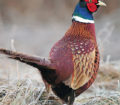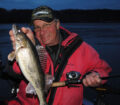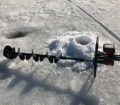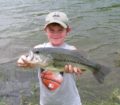By Steve Weisman
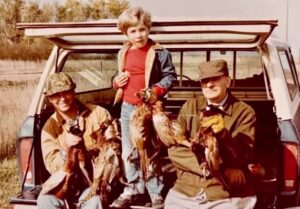
(photo by Darial Weisman) Six-year-old Curt Weisman (middle) holds two of the five rooster pheasants that dad (Steve) and grandpa (Elton) had bagged on the Weisman farm.
From the time I was a little kid, I lived for the opener of pheasant season. And why not? I lived on a farm several miles south of Redfield in northcentral South Dakota, a town that was widely acclaimed as the “Pheasant Capital of the World!” As a grade schooler in the late mid to late 50s, I could not wait until the South Dakota opener the third Saturday of October.
Since the opener never started before noon and we hunted my dad’s and neighbors’ standing corn fields, shelterbelts and grasslands, my mom would take me up to Redfield to go by the Redfield airport on the outskirts of town.
Why? Well, we’d go slow and stop at an approach, and I’d start counting airplanes that had carried out-of-state hunters from all over the country and beyond! It was nothing for me to count at least 100 planes. Information from the local paper in 1962 noted that somewhere around 150 planes had landed at the Redfield airport. That’s not to count the countless out of town hunters that had arrived by car!
I was in awe as my mom drove into Redfield, and we saw all the cars parked and hunters just about everywhere! Hardware stores, restaurants and gas stations were packed.
Some visitors would be there for just the weekend; others were there for five days. However, over the first two weeks of the season, outgoing airplanes were replaced with incoming airplanes day after day.
It didn’t matter to me as a grade schooler, but famous people in all walks of life, from athletes to ball players to actors…heck, even Ty Cobb came to pheasant hunt back in the day.
Cool, but how about the hunt!
In the late 50’s I was too young to carry a gun, but I was sure included in the hunts. My dad, uncles and other neighbors were all farmers, and we’d get together to work corn fields, shelterbelts and soil bank acres pushing with several drivers, while others blocked at the end of the field. The walkers always walked in a line for safety. There was no rush, because we wanted to make the pheasants nervous and get them to flush. In those days, none of the hunters had a dog, so I guess I was there to do the job of a hunting dog. In addition, it was my job to be a spotter for downed birds and to help find them. I also get conned into carrying bagged birds for the hunters that didn’t have a game carrier…that would be my dad!
The cornfields in those days were not the height of fields today, and certainly the size of the field was much smaller. The rows had lots of pigeon grass in them. That made perfect cover. The end of the field was incredible on the opener as many of the pheasants hadn’t flushed, and they would erupt at the end of the field. With only waist to shoulder high corn for the men, it was pretty easy to see the birds and make the swing.
Shelterbelts were really something. Most had been planted as wind breaks several years before, so they were mature and tough to walk through. Once again, I became the flusher, moving through the shelterbelt, making as much noise as I possibly could. Some of the adults would walk on the outside edge on each side, others would spread themselves out along the length of the shelter belt, while 2-3 would block at the end. There was lots of noise as we tried to get the pheasants to erupt!
The third option was the Soil Bank. This was a program in the 1950s and 1960s that was designed to help reduce farm production, help increase prices and drive down surpluses. It paid farmers for 10 years to take land out of production. For my dad, it gave him the chance to retire some of his worst land, while helping to revitalize the ground and provide a way to protect the upland birds. It paved the way for the later Conservation Reserve Program (CRP). Most of the plantings were pretty simple: a mix of alfalfa and brome grass. However, the Soil Bank acres were also a draw for upland birds. Once the birds had been flushed from the cornfields, the birds would head to the Soil Bank, and it was time to walk the grasses. It was certainly much easier to walk than the tall grass/mixed prairie plantings that we have today.
Of course, laughter often erupted along with joking about missed and errant shots, as well as shouts of encouragement when someone made one of those incredibly difficult side or long-range shots! We took breaks to rest between fields, and that was the time that the stories began. As a kid, I just loved being able to be around to hear the stories and think maybe I was an adult, too!
When I graduated from college in 1970, I was dating my future wife, who grew up in Redfield. Her dad (Alvin Scheffel) was a family physician there and was a huge hunter. Each year, his three brothers and wives would come for the pheasant opener and hunt some of his land and also land that his wife’s brother owned southwest of Redfield. We’d also head to my dad’s land. Oh, what fun that was! By the time my son, Curt was six years in 1982, he was tagging along just like I used to do with my dad! It was moving toward a three-generation hunt.
Lots of pushing pheasants in the standing cornfields and shelterbelts with blockers to stop the pheasants from escaping out the end. Still no dogs, just lots of walking and noise to spook the birds. In the early 60s, Alvin had actually hosted and hunted with several celebrates who came to experience the best of South Dakota pheasant hunting. It’s pretty cool that there were very few if any commercial hunting operations that have become so common over the past 20 years or.
Oh, for the memories!
Today, I am passing this tradition given to me by my dad and father-in-law on to my son and grandsons. It’s a long, long time away, but I am hoping that the great grandkids might show some interest, too!

